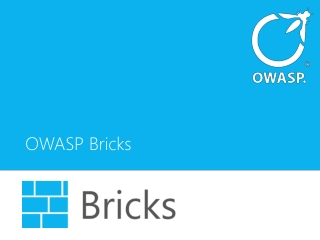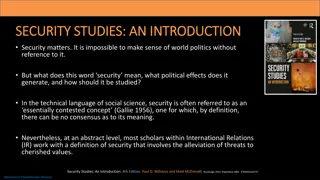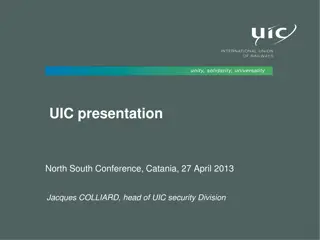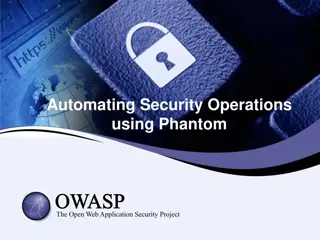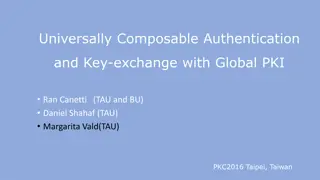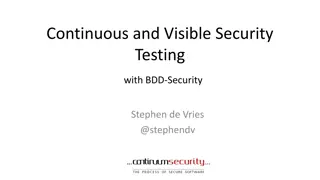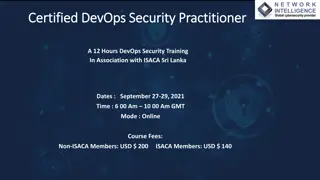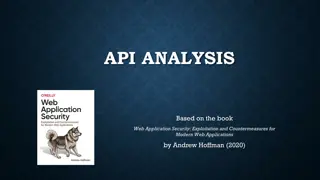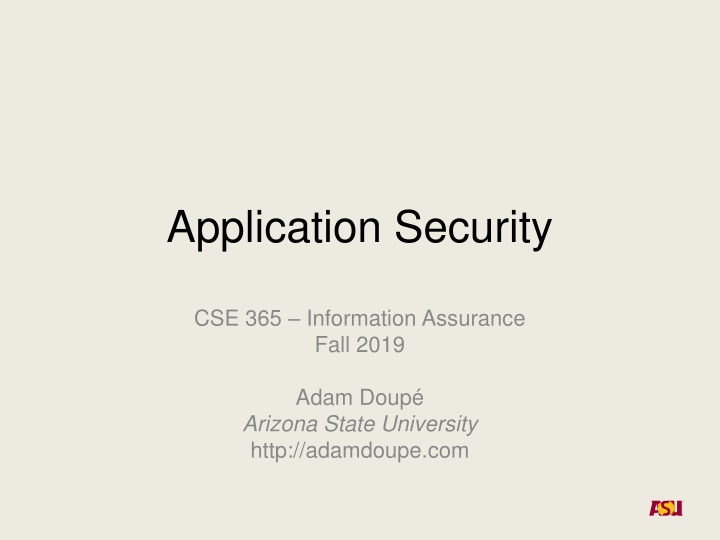
Application Security and Vulnerability Analysis
Learn about the importance of application security, the different types of attacks, the vulnerabilities in applications, and the process of vulnerability analysis. Discover the differences between local and remote attacks, as well as the life cycle of an application.
Download Presentation

Please find below an Image/Link to download the presentation.
The content on the website is provided AS IS for your information and personal use only. It may not be sold, licensed, or shared on other websites without obtaining consent from the author. If you encounter any issues during the download, it is possible that the publisher has removed the file from their server.
You are allowed to download the files provided on this website for personal or commercial use, subject to the condition that they are used lawfully. All files are the property of their respective owners.
The content on the website is provided AS IS for your information and personal use only. It may not be sold, licensed, or shared on other websites without obtaining consent from the author.
E N D
Presentation Transcript
Application Security CSE 365 Information Assurance Fall 2019 Adam Doup Arizona State University http://adamdoupe.com
Application Security Applications provide services Locally (word processing, file management) Remotely (network services) The behavior of an application is determined by the code being executed, the data being processed, and the environment in which the application is run Application attacks attempt to Violate confidentiality Violate integrity Violate availability Adam Doup , Information Assurance
Application Model Environment Process Application Terminal OS Network File System Adam Doup , Information Assurance
Application Vulnerability Analysis Application vulnerability analysis is the process of identifying vulnerabilities in applications, as deployed in a specific operational environment Design vulnerabilities Implementation vulnerabilities Deployment vulnerabilities Adam Doup , Information Assurance
Remote vs. Local Attacks Local attacks Allow one to manipulate the behavior of an application through local interaction Require a previously-established presence on the host (e.g., an account, or another application under the control of the attacker) Allow one to execute operations with privileges that are different (usually superior) from the ones that the attacker would otherwise have In general these attacks are easier to perform, because the attacker has a better knowledge of the environment Remote attacks Allow one to manipulate the behavior of an application through network-based interaction Unauthenticated remote attacks: Interaction with the application does not require authentication or prior capabilities Allow one to execute operations with the privileges of the vulnerable application In general, are more difficult to perform but they do not require prior access to the system
The Life of an Application Author writes code in high-level language The application is translated in some executable form and saved to a file Interpretation vs. compilation The application is loaded in memory The application is executed The application terminates Adam Doup , Information Assurance
Interpretation The program is passed to an interpreter The program might be translated into an intermediate representation Python byte-code Each instruction is parsed and executed In most interpreted languages it is possible to generate and execute code dynamically Bash: eval <string> Python: eval(<string>) JavaScript: eval(<string>) Adam Doup , Information Assurance
Compilation The preprocessor expands the code to include definitions, expand macros GNU/Linux: The C preprocessor is cpp The compiler turns the code into architecture-specific assembly GNU/Linux: The C compiler is gcc gcc -S prog.c will generate the assembly Use gcc s-m32 option to generate 32-bit assembly Adam Doup , Information Assurance
Compilation The assembler turns the assembly into a binary object GNU/Linux: The assembler is as A binary object contains the binary code and additional metadata Relocation information about things that need to be fixed once the code and the data are loaded into memory Information about the symbols defined by the object file and the symbols that are imported from different objects Debugging information Adam Doup , Information Assurance
Compilation The linker combines the binary object with libraries, resolving references that the code has to external objects (e.g., functions) and creates the final executable GNU/Linux: The linker is ld Static linking is performed at compile-time Dynamic linking is performed at run-time Most common executable formats: GNU/Linux: ELF Windows: PE Adam Doup , Information Assurance
Compilation The linker combines the binary object with libraries, resolving references that the code has to external objects (e.g., functions) and creates the final executable GNU/Linux: The linker is ld Static linking is performed at compile-time Dynamic linking is performed at run-time Most common executable formats: GNU/Linux: ELF Windows: PE Adam Doup , Information Assurance
The ELF File Format The Executable and Linkable Format (ELF) is one of the most widely-used binary object formats ELF is architecture-independent ELF files are of four types: Relocatable: need to be fixed by the linker before being executed Executable: ready for execution (all symbols have been resolved with the exception of those related to shared libs) Shared: shared libraries with the appropriate linking information Core: core dumps created when a program terminated with a fault Tools: readelf, file Adam Doup , Information Assurance
Typical ELF Sections Name .text Description the program s code Type PROGBITS Flags ALLOC and EXECINSTR .data initialized data PROGBITS ALLOC and WRITE .rodata read-only data PROGBITS ALLOC .bss uninitialized data NOBITS ALLOC .init and .fini pre and post code PROGBITS ALLOC and EXECINSTR
The x86 CPU Family 8088, 8086: 16 bit registers, real-mode only 80286: 16-bit protected mode 80386: 32-bit registers, 32-bit protected mode 80486/Pentium/Pentium Pro: Adds few features, speed-up Pentium MMX: Introduces the multimedia extensions (MMX) Pentium II: Pentium Pro with MMX instructions Pentium III: Speed-up, introduces the Streaming SIMD Extensions (SSE) Pentium 4: Introduces the NetBurst architecture Xeon: Introduces Hyper-Threading Core: Multiple cores AMD Opteron: 64 bit architecture Adam Doup , Information Assurance
x86 Registers Registers represent the local variables of the processor There are four 32-bit general purpose registers eax/ax, ebx/bx, ecx/cx, edx/cx Convention Accumulator: eax Pointer to data: ebx Loop counter: ecx I/O operations: edx eax ah al ax esi si
x86 Registers Two registers are used for high-speed memory transfer operations esi/si (source), edi/di (destination) There are several 32-bit special purpose registers esp/sp: the stack pointer ebp/bp: the frame pointer eax ah al ax esi si
x86 Registers Segment registers: cs, ds, ss, es, fs, gs Used to select segments (e.g., code, data, stack) Program status and control: eflags The instruction pointer: eip Points to the next instruction to be executed Cannot be read or set explicitly It is modified by jump and call/return instructions Can be read by executing a call and checking the value pushed on the stack Floating point units and mmx/xmm registers Adam Doup , Information Assurance
Beware of the Endianess (and of Signed Integers)! Intel uses little endian ordering 0x03020100 starting at address 0x00F67B40 0x00F67B40 00 0x00F67B41 01 0x00F67B42 02 0x00F67B43 03 Signed integers are expressed in 2 s complement notation The sign is changed by flipping the bits and adding one, ignoring the overflow -1 is 0xFFFFFFFF -2 is 0xFFFFFFFE ?? is 0xFFFFF826 Having a calculator handy is a good thing... Adam Doup , Information Assurance
x86 Assembly Language (Slightly) higher-level language than machine language Program is made of: directives: commands for the assembler .data identifies a section with variables instructions: actual operations jmp 0x08048f3f Two possible syntaxes, with different ordering of the operands! AT&T syntax (objdump, GNU Assembler) mnemonic source, destination DOS/Intel syntax (Microsoft Assembler, Nasm, IDA Pro) mnemonic destination, source In gdb can be set using: set disassembly-flavor intel/att Adam Doup , Information Assurance
Addressing Memory Memory access is composed of width, base, index, scale, and displacement Base: starting address of reference Index: offset from base address Scale: Constant multiplier of index Displacement: Constant base Width: (address suffix) size of reference (b: byte, s: short, w: word, l: long, q: quad) Address = base + index*scale + displacement displacement(base, index, scale) Example: movl -0x20(%eax, %ecx, 4), %edx Adam Doup , Information Assurance
Addressing Memory movl -8(%ebp), %eax copies the contents of the memory pointed by ebp - 8 into eax movl (%eax), %eax copies the contents of the memory pointed by eax to eax movl %eax, (%edx, %ecx, 2) moves the contents of eax into the memory at address edx + ecx * 2 movl $0x804a0e4, %ebx copies the value 0x804a0e4 into ebx movl (0x804a0e4), %eax copies the content of memory at address 0x804a0e4 into eax Adam Doup , Information Assurance
Instruction Classes Data transfer mov, xchg, push, pop Binary arithmetic add, sub, imul, mul, idiv, div, inc, dec Logical and, or, xor, not Adam Doup , Information Assurance
Instruction Classes Control transfer jmp, call, ret, int, iret Values can be compared using the cmp instruction cmp src, dest # subtracts src from dest without saving the result Various eflags bits are set accordingly jne (ZF=0), je (ZF=1), jae (CF=0), jge (SF=OF), Control transfer can be direct (destination is a constant) or indirect (the destination address is the content of a register) Input/output in, out Misc nop Adam Doup , Information Assurance
Invoking System Calls System calls are usually invoked through libraries Linux/x86 int 0x80 eax contains the system call number Adam Doup , Information Assurance
Hello World! .data hw: .text .globl main main: movl $4,%eax movl $1,%ebx movl $hw,%ecx movl $12,%edx int movl $0,%eax ret .string "Hello World\n" $0x80 Adam Doup , Information Assurance
Program Loading and Execution When a program is invoked, the operating system creates a process to execute the program The ELF file is parsed and parts are copied into memory In Linux /proc/<pid>/maps shows the memory layout of a process Relocation of objects and reference resolution is performed The instruction pointer is set to the location specified as the start address Execution begins Adam Doup , Information Assurance
Process Memory Layout x86 0xffffffffff 1GB Kernel 0xc0000000 0xbfffffff 3GB Program 0x00000000 Adam Doup , Information Assurance
Process Structure Environment/Argument section Used for environment data Used for the command line data Stack section Used for local parameters Used for saving the processor status Memory-mapping segment Used for shared libraries Heap section Used for dynamically allocated data Data section (Static/global vars) Initialized variables (.data) Uninitialized variables (.bss) Code/Text section (.text) Marked read-only Modifications causes segfaults Top of memory (0xBFFFFFFF) Env/Argv Strings Env/Argv Pointers Argc Stack Shared Libraries Heap Data (.bss) Data (.data) Code (.text) Bottom of memory (0x00800000)
Disassembling Disassembling is the process of extracting the assembly representation of a program by analyzing its binary representation Disassemblers can be: Linear: linearly parse the instructions Recursive: attempt to follow the flow of the program Adam Doup , Information Assurance
Radare Radare is a program analysis tool http://rada.re/r/ Supports reversing and vulnerability analysis Disassembling of binaries Forensic analysis Supports scripting Supports collaborative analysis Free Adam Doup , Information Assurance
IDA Pro IDA Pro is the state-of-the-art tool for reversing https://www.hex-rays.com/products/ida/ It supports disassembling of binary programs Supports decompilation (Hex-Rays decompiler) Can be integrated with gdb and other debuggers It is a commercial product (expensive) A limited version is available for free Adam Doup , Information Assurance
Hopper Disassembler that supports sophisticated analysis http://www.hopperapp.com/ Includes a decompiler It is a commercial product but: It can be used for free (with limitations) It is not very expensive (~90$) Adam Doup , Information Assurance
Attacking UNIX Systems Remote attacks against a network service Remote attacks against the operating system Remote attacks against a browser Local attacks against SUID applications Local attacks against the operating system Adam Doup , Information Assurance
Attacking UNIX Applications 99% of the local vulnerabilities in UNIX systems exploit SUID-root programs to obtain root privileges 1% of the attacks target the operating system kernel itself Attacking SUID applications is based on Inputs Startup: command line, environment During execution: dynamic-linked objects, file input, socket input Interaction with the environment File system: creation of files, access to files Processes: signals, invocation of other commands Sometimes defining the boundaries of an application is not easy Adam Doup , Information Assurance
Attack Classes File access attacks Path attacks TOCTTOU File handler reuse Command injection Memory Corruption Stack corruption Heap corruption Format string exploitation Adam Doup , Information Assurance
File Access Attacks Access to files in the file system is performed by using path strings If an attacker has a way to control how or when a privileged application builds a path string, it can lure the application into violating the security policy of the system Adam Doup , Information Assurance
The Dot-Dot Attack An application builds a path by concatenating a path prefix with values provided by the user (the attacker) path = strncat("/<initial path>/", user_file, free_size); file = open(path, O_RDWR); The user (attacker) provides a filename containing a number of .. that allow for escaping from the directory and access any file in the file system Also called: directory traversal attack Adam Doup , Information Assurance
PATH and HOME Attacks The PATH environment variable determines how the shell searches for commands If an application invokes commands without specifying the complete path, it is possible to induce an application to execute a different version (controlled by the attacker) of the external command execlp() and execvp() use the shell PATH variable to locate applications The HOME environment variable determines how the home directory path is expanded by the shell If an application uses using a home-relative path (e.g., ~/myfile.txt), an attacker can modify his/her $HOME variable to control the execution of commands (or the access to files) Adam Doup , Information Assurance
Command Injection Applications invoke external commands to carry out specific tasks system(<string>) executes a command specified in a string by calling /bin/sh -c <string> popen() opens a process by creating a pipe, forking, and invoking the shell as in system() If the user can control the string passed to these functions, it can inject additional commands Adam Doup , Information Assurance
A Simple Example int main(int argc, char *argv[]) { char cmd[1024]; snprintf(cmd, 1024, "cat /var/log/%s", argv[1]); cmd[1023] = '\0'; return system(cmd); } % ./prog "foo; cat /etc/shadow" /var/log/foo: file not found root:$1$LtWqGee9$jLrc8CWVMx6oAA8WKzS5Z1:16661:0:99999:7::: daemon:*:16652:0:99999:7::: 43 Adam Doup , Information Assurance
A Real Example: Shellshock On September 2014, a new bug in how bash processes its environment variable was disclosed The bash program can pass its environment to other instances of bash In addition to variables a bash instance can pass to another instance one or more function definitions This is accomplished by setting environment variables whose value start with () followed by a function definition The function definition is the executed by the interpreter to create the function Adam Doup , Information Assurance
A Real Example: Shellshock By appending commands to the function definition, it is possible to execute arbitrary code Example: If a user has access to a limited-access ssh account he/she can break out of the restricted shell When a command that is not the allowed one is requested, the original command is put in the variable $SSH_ORIGINAL_COMMAND By passing as a command the string: () { :;}; cat /etc/shadow The command will be put in the environment variable and interpreted, resulting in the injected command executed Also, CGI web applications pass arguments through environment variables Can execute arbitrary code through a web request! Adam Doup , Information Assurance
Overflows/Overwrites The lack of boundary checking is one of the most common mistakes in C/C++ applications Overflows are one of the most popular type of attacks Architecture/OS version dependant Can be exploited both locally and remotely Can modify both the data and the control flow of an application Recent tools have made the process of exploiting overflows easier if not completely automatic Much research has been devoted to finding vulnerabilities, designing prevention techniques, and developing detection mechanisms Some of these mechanisms have found their way to mainstream operating system (non-executable stack, layout randomization) Adam Doup , Information Assurance
The Stack Stack is essentially scratch memory for functions Used in MIPS, ARM, x86, and x86-64 processors Starts at high memory addresses and grows down Functions are free to push registers or values onto the stack, or pop values from the stack into registers The assembly language supports this on x86 %esp holds the address of the top of the stack push %eax decrements the stack pointer (%esp) then stores the value in %eax to the location pointed to by the stack pointer pop %eax stores the value at the location pointed to by the stack pointer into %eax, then increments the stack pointer (%esp) Adam Doup , Information Assurance 47
Stack Example 0xFFFFFFFF push %eax pop %ebx 0x10000 Garbage 0x00000000 %eax 0xa %ebx 0x0 %esp 0x10000 Adam Doup , Information Assurance 48
Stack Example 0xFFFFFFFF push %eax pop %ebx 0x10000 Garbage 0x00000000 %eax 0xa %ebx 0x0 %esp 0x10000 Adam Doup , Information Assurance 49
Stack Example 0xFFFFFFFF push %eax pop %ebx 0x10000 0xa Garbage 0x00000000 %eax 0xa %ebx 0x0 %esp 0xFFFC Adam Doup , Information Assurance 50
Stack Example 0xFFFFFFFF push %eax pop %ebx 0x10000 0xa Garbage 0x00000000 %eax 0xa %ebx 0x0 %esp 0xFFFC Adam Doup , Information Assurance 51
Stack Example 0xFFFFFFFF push %eax pop %ebx 0x10000 0xa Garbage 0x00000000 %eax 0xa %ebx 0xa %esp 0xFFFC Adam Doup , Information Assurance 52
Stack Example 0xFFFFFFFF push %eax pop %ebx 0x10000 0xa Garbage 0x00000000 %eax 0xa %ebx 0xa %esp 0x10000 Adam Doup , Information Assurance 53


